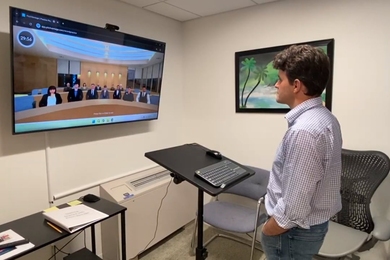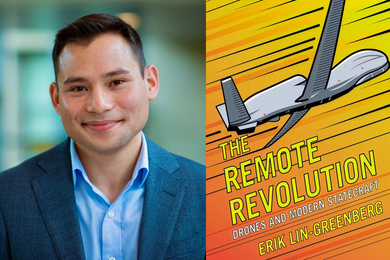This is the second in a series of articles that will be published periodically to highlight new ways in which people are working at MIT. The first, which appeared in the April 1 issue of MIT Tech Talk, was about four employees who work part-time at MIT because of their outside interests, other work or family issues. This installment will look at a particular aspect of part-time work -- job-sharing -- in which two people work part-time and share one position. The next article in this series will be on negotiating for job flexibility.
Job-sharing at MIT began because several departments wanted to keep valued employees who, for personal reasons, needed to work less than full-time. Rather than losing good support staff members, Resource Development, the Medical Department and the Department of Athletics each decided to offer an employee the option of cutting back to a part-time schedule and adding another person to share the position.
Though this concept is still rare at MIT, it may be one that grows in the future as employees seek more flexibility in their work schedules. Job-shares are not tracked separately from other part-time positions at MIT, but personnel officers were aware of at least three support staff job-sharers in Resource Development, three in MIT Medical and one in Athletics.
Sharing a position with another person is probably trickier than holding a normal part-time job simply because of the shared nature of the work. The partners have to operate as a team, even though they work at different times. Good communication is critical to success. Most job-sharers at MIT use notes, e-mail messages and phone calls to communicate with one another so that no details slip through the cracks. Several have a short time period each week (even just a half-hour) when their schedules overlap.
Judy Leonard and Cynthia Silck-Flannery, who share a position in the Research and Systems office of Resource Development, use several additional methods to communicate the status of work. They both complete a weekly "shift-end report" and also use clipboards for each of their current projects. The clipboards are convenient to take to a meeting or the phone, and are easy to find and update -- both for them and for their co-workers.
There are certainly advantages to job-share situations for both the employees and their departments. Employees who work at least 50 percent of a full-time schedule earn MIT benefits and also have more time to deal with family commitments or outside interests. The areas they work in get additional depth in the position from the experience and skills provided by two people rather than just one.
In Athletics, for example, Michelle Harper's full-time position was changed to a job-share after she became a mother. She had managed the process of tracking MIT seniors who hadn't completed their physical education requirement, and she continues that responsibility in the job-share. Her job partner, Temple Odom, always handles the payroll duties for the department.
Rhonda Ferrino and Laura Paul share the administrative secretary position that had formerly been Ms. Ferrino's full-time job in the office of the Vice President for Resource Development. Ms. Ferrino wanted to work fewer hours in order to spend more time with her children, and she's now at MIT the first three days of the week. Ms. Paul, who also has young children, works on Thursday and Friday. The two collaborate closely to cover the needs of the office, and they individually bring skills such as planning, scheduling, organizing and writing to their partnership.
"We have found that job-share arrangements require a certain set of complex skills in communication and organization," said Barbara Stowe, vice president for resource development. "The partners need to plan ahead and know which person will take the lead on any assignment. It's a little like a relay race, passing the baton on a variety of tasks. We have found employees who are committed to the success of their job shares, and they are willing to put great effort into making them seamless."
Ms. Leonard and Ms. Silck-Flannery, whose work involves the central donor and prospect files for the Institute, feel that their personal skills and traits complement each other and benefit the office. "Cindy is fantastic at charts and tracking reports and hunting down files," Ms. Leonard said. "I like organizing and laying out the steps for projects, and then doing follow-up and progress reports."
One advantage that Medical Department job-sharers enjoy is that their job partners cover for each other when one goes on vacation. Coverage and consistency of schedules are important because these job-share positions are all in patient care areas. The employees greet patients and let the doctors and nurses know who is waiting to be seen. In addition, they book appointments for many special procedures and file lab and pathology reports.
The Medical Department does have to spend more because they are covering benefits for six rather than three employees. However, Pat Mellman, coordinator of clinical support services, sees job-sharing as a way of accommodating people who need to work part-time.
"I think there's also a freshness in having two people in a position where you're interacting with the public," said Debbie Solari, a job-sharer in dermatology. "Wednesday afternoon, when I start work, is like my Monday morning."
Several of MIT's job-share employees work part-time because of family responsibilities; others have different reasons for working fewer hours. Ms. Odom wanted a part-time position because she was beginning graduate work on her master's degree in marriage and family therapy at the University of Massachusetts. Ms. Leonard wanted to create a better balance in her life. In her previous full-time position -- not at MIT -- she found that she barely had time to share a meal with her husband.
"I'd gotten to the point where I was dragging my work with me wherever I went. All I could talk about was work, and even my social calendar was strictly job-related," she said.
Job-sharing has helped Ms. Leonard find the balance she was seeking. She now works two and a half days at MIT and also holds a part-time job at the auction and appraisal firm of Skinner, Inc. That position provided her with a new interest and a learning opportunity, and she started her own small antique business in 1991.
"I'm a great fan of this 'living while you work' plan," Ms. Leonard said.
Some of MIT's job-share employees found their positions through word of mouth; others saw them listed as part-time jobs by Personnel. Procedural details of a job-share arrangement are discussed among the supervisor and the employees. These would include things like the specific work hours, whether vacation coverage is expected, and what would happen if one of the partners leaves. Several of the employees contacted for this article said they wished there was more publicity for the concept of job-sharing -- perhaps through a special listing in Personnel or an electronic bulletin board for people seeking a job-share situation.
A version of this article appeared in MIT Tech Talk on May 20, 1998.





